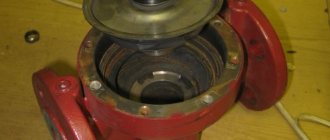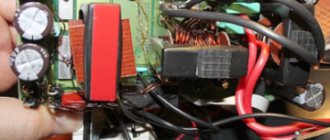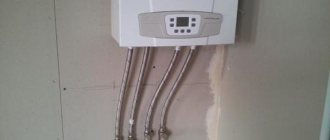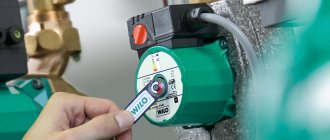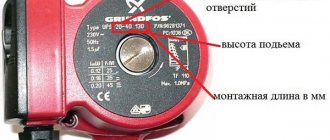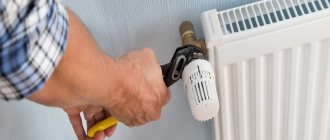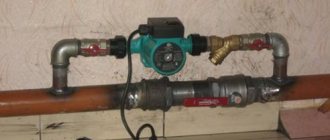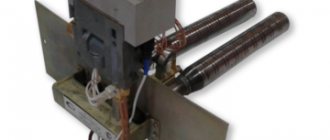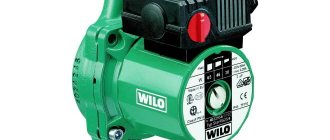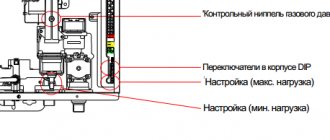Modern circulation pumps require virtually no maintenance, and if a heating circulation pump needs to be repaired, it is better to entrust this task to a specialist from the service center. However, in order to prevent equipment breakdown, you can take some measures that will help prevent such an unpleasant event.
Circulation pumps
Common faults and solutions
The pump makes a loud noise when starting the pump, but the impeller does not spin. This usually happens if the engine shaft itself is oxidized or heavily rusted.
This happens due to the fact that the pump was installed at an angle from a horizontal reference, or due to the circulation pump being idle for a long time without use.
The process of restoring functionality is carried out as follows:
- The first step is to completely disconnect the device from the power supply.
- Drain the coolant from the pump and the adjacent piping circuit.
- Unscrew all pipeline connections (the so-called American ones), remove the motor along with the rotor.
- Take a strong plastic or wooden object, rest it on the pump body and force the impeller out of its dead position. After this, the pump should be reassembled in the reverse order; at first it will be a little noisy, but gradually it will get used to it and quiet down.
In rare cases, the pump begins to hum after a foreign object gets under the impeller. In such a situation, the pump is disassembled according to the instructions described above, the foreign body is removed, and then reassembled in the reverse order.
Only now you need to install a filter mesh before the coolant inlet so that a similar malfunction does not happen in the future.
The pump does not make any sounds and does not work
In this case, you should look for a fault in the power outlet or switch. An indicator screwdriver for determining the phase or a multimeter will help you with diagnostics. If everything is fine with the power in the outlet, then you should check the cable for a break.
If everything is fine here, then with a 90% probability the motor winding has been broken. Then the circulation pump needs to be replaced, since no one is restoring the winding.
We install the circulation pump ourselves and check it, or we call a specialist to your home for this work.
After a short period of operation, the pump turns off by itself.
This usually happens due to the fact that the water in the heating circuit is extremely highly mineralized, so lime deposits appear on the impeller during operation.
- Here the restoration work is not particularly complicated, you just need to disassemble the pump, dismantle it, and then disassemble it (just unscrew a few bolts around the perimeter of the device).
- Next, the impeller is cleaned; a brush and warm water with citric acid are ideal.
- After this, the working mechanism is washed under running water. At the end of the work, the circulation pump is assembled and subsequently installed.
When started, the pump spins and circulates coolant, but during operation it makes a loud noise.
This happens due to strong air in the heating system. To restore normal operation of the pump, you need to add water or antifreeze to the system, and then remove air from all pipes and radiators.
System design and causes of failure
The reasons for device failure can be very different, so you need to know certain design features before starting repairs. The malfunction may be due to non-compliance with specific operating rules.
Damage can be caused by:
- Changes in the power supply network;
- Problems with coolant quality.
The circulation pump may break down due to wear of parts.
Before deciding to repair the pump yourself, you need to have a good understanding of its design and find out what its operating principle is. Thanks to this, it will be possible to find out the specific cause of the problem.
The pump structure consists of:
- An electric motor in which the shaft is connected to the rotor;
- Housing made of non-ferrous alloys or stainless steel;
- A rotor on which a wheel with blades is installed, made of polymer materials or metal.
It is important to know the design of the circulation pump in order to carry out repair and maintenance work correctly and in a timely manner.
The pump works but vibrates a lot
There are only 2 reasons for this:
- The rotor has somehow shifted from its normal axis of rotation;
- The working shaft bearing is worn out.
The problem is solved by replacing the bearing (if possible) or replacing the pump.
MrPodshipnik
Bearing replacement, repair
Enter the marking or size (for example: 8*22*7) of the product and the country of sale
New instructions
Do-it-yourself replacement of heating circulation pump bearings
This article will give you the opportunity to independently replace failed bearings in the circulation pump.
As a rule, circulation pumps that are used for heating homes and industrial premises do not need repairs.
Their simple and reliable design always ensures good operation of the thermal system for a long time.
However, nothing lasts forever. They break too.
The pump creates a weak coolant circulation pressure
Main reasons:
- The pump impeller rotates in the opposite direction.
- The wiring in the electrical distribution box is incorrectly connected (with a 3-phase connection).
- Increased density of the coolant (this can happen due to the fact that dirty water was drawn into the system after repair work was carried out on the water supply main).
- The heating system filter element is clogged.
This problem is solved depending on the cause.
Revision of the motor part
Deep well pumps are equipped with a single-phase, mostly brushless induction motor. The connection diagram contains a starting capacitor. The stator of the electric motor has a monolithic attachment to the housing; it is often filled with epoxy compound.
In pumps of a monolithic design, the motor must be squeezed out of the glass by pressing on the connection outlet of the outgoing pipeline with the impellers removed. In rod pumps, the motor part is disconnected when the two halves are separated, in screw pumps - after removing the working screw. In all cases, the insides of the engine (capacitor, connecting terminals) can only be accessed after removing the sealed plug. It is fixed with 2-3 screws on the side surface of the sleeve and a powerful locking ring. In some types of pump, the plug may require the use of a special puller.
Well pump motor stator
All well pump motors are filled with oil, which performs lubricating, cooling and dielectric functions. The oil used is special food grade, but it is commercially available. Signs of low quality may be a cloudy color of the oil when mixed with water, darkening or the presence of mechanical impurities, as well as insufficient levels. If the oil is normal, it should be drained into a clean, dry container, leaving the motor housing for 15–20 minutes until the residue completely drains from the walls. Insufficient oil filling of the engine indicates wear of the oil seals.
In addition to spoiled oil, engine malfunctions can be caused by worn bearings, which can be determined by play and free-wheeling noise. If the pump has been operated for a long time under extreme conditions, the shaft may be bent (twisted) and the winding insulation may overheat. Burnt stators are practically beyond repair, but they are quite easy to replace.
Burning of the stator winding due to water entering the motor
The pump gets very hot even when the boiler is cold
Excessive heating of the pump using cold coolant indicates that it is operating at increased load. Therefore, you should disassemble it yourself and check everything or send it to a diagnostic center, where this work will be performed by qualified craftsmen.
Design
Almost all circulation pumps are centrifugal type. They have an impeller mounted on the motor shaft and placed in a special “shell” chamber. The entrance to the shell is located in the center, while the exit is the outer edge of the shell with a channel extending around the circumference in the direction of movement of the impeller. The engine spins the impeller, and water, under the influence of centripetal force, rushes from the center to the edges of the sink from inlet to outlet.
Pump structural elements:
- pump part, sink and impeller mounted on the shaft;
- electric motor;
- electronic control unit.
The most susceptible to wear is the moving part of the pump - the motor shaft and impeller, as well as the bearings on which they are mounted.
How to disassemble a circulation pump
You need to understand that it is impossible to carry out high-quality repairs without disassembling the unit itself, so you need to learn how to disassemble it correctly.
First of all, the pump should be disconnected from the power supply.
- To disconnect the cable from the junction box, you need to remove the housing from the pump supply unit.
- After this, you need to close the ball valves at the edges of the pump, this is done so that the main part of the coolant remains in the system.
- Then all the bolts are unscrewed from the circulation pump housing, for this you use a socket wrench or hexagon
Note! You may encounter such a problem that the fasteners are thoroughly stuck. The popular WD-40 product will help you here; after half an hour you can try to unscrew the bolt again. This product is characterized by increased fluidity, so it is often used not only in everyday life, but also by plumbers and car mechanics.
Then carefully remove the cover of the unit, there you will see the pump motor itself, as well as the impeller, which distills the water in the system.
You need to remove the rotor; it is secured with several bolts in a circle. After this, you will have full access to all parts of the device, then it will be easier for you to diagnose and carry out repairs.
We are confident that you will be able to apply this material in practice and carry out competent repairs of the boiler circulation pump. Good luck to you!
Replacing the repair kit
Replacing the circulation apparatus repair kit includes:
- disassembling the pump part of the device;
- replacement of components;
- checking engine operation;
- device assembly;
- diagnostics of equipment operation.
Some manufacturers offer ready-made repair kits for pumping equipment. For example, a repair kit for a circulation pump u4814 with a capacity of 5200 l/h, voltage 12/24 V and a pipe diameter of 38 mm. Purchasing such a kit will reduce the waste of time and money.
Air removal scheme
You should repair the circulation device yourself only after the warranty period has expired or if it is impossible to call a repair specialist. Some pump components are difficult to find on the open market, which is explained by the trade policies of the manufacturing companies.
Photos of reliable circulation pump models
Preparation for use
Before the onset of the cold season, prepare the entire heating system for operation.
To do this, you must complete the following steps:
— check the pipelines and pump for leaks. Tighten all fasteners and coupling. Replace gaskets and seals;
- Check the cleanliness of the mesh filter again. Clean it if necessary;
- check for lubrication in all rotating parts, especially the bearing;
— check for normal voltage. It should be 220 V. If this figure is not available, contact the energy company;
— check how the system works. Turn it on. Let him work for two or three hours.
So you have independently repaired and replaced the bearing of the centrifugal heating pump of your home.
Thanks to this article.
If you have any questions or problems during the repair and replacement of parts, please contact me in the comments.
Features of application
Pumps are used in home heating systems to ensure forced movement of coolant along the circuit. This makes it possible to heat large areas when the pipes are so long that the natural flow of liquid is difficult.
Sometimes the water moves so slowly that it has time to cool before entering the boiler to be reheated. A circulation pump was developed specifically to solve such problems.
Recommendations for the user
To avoid breakdowns, you must adhere to the following rules:
- do not turn on the equipment idle when there is no coolant in the system circuit;
- do not use the pump at zero flow;
- do not allow excessively low or high fluid supply;
- heat the coolant in the system circuit to a temperature of no more than 65°C, otherwise salts will precipitate. Even better is to fill the boiler and circuit with softened water;
- avoid long downtime of the pump, and even in the summer season you need to turn it on for 10-15 minutes at least once a month to avoid blocking the shaft as a result of oxidation;
- flush the heating system before use;
- monitor the quality of the power supply: faults are possible in the network, including power surges.
